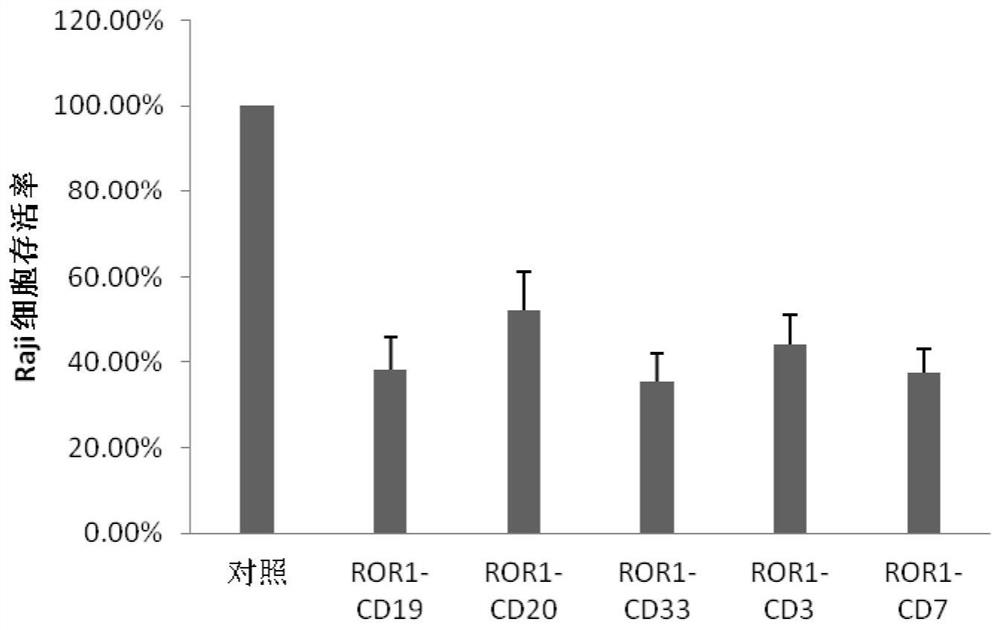Bispecific chimeric antigen receptor (CAR) targeting ROR1 and CD7 and application thereof
A chimeric antigen receptor and bispecific technology, which is applied to the bispecific chimeric antigen receptor and the application field of preparing antitumor drugs, can solve the problems of lack of CART cells, etc., to inhibit tumor growth and improve tumor target. The effect of improving tropism and expression level
- Summary
- Abstract
- Description
- Claims
- Application Information
AI Technical Summary
Problems solved by technology
Method used
Image
Examples
Embodiment 1
[0025] Embodiment 1: CART cell preparation
[0026] 1.1 Chimeric antigen receptor design
[0027] The bispecific chimeric antigen receptor provided in the present invention has the following structure: ROR1 scFv-X scFv-H-TM-C-CD3ζ where "-" is a connecting peptide or a peptide bond; H is a hinge region; TM is Transmembrane domain; C is a co-stimulatory signal molecule; CD3ζ is an intracellular signal transduction sequence; X scFv is selected from scFv targeting CD19, CD20, CD33, CD7 or CD3. The amino acid sequence and nucleotide sequence of each scFv were prepared and preserved by the inventors in earlier experiments.
[0028] 1.2 Viral vector transfection of T cells
[0029] In the present invention, multiple chimeric antigen receptor structures with bispecificity were constructed in order to verify the combined effects of ROR1 targets and other anti-tumor targets such as CD19, CD20, CD33, CD7 or CD3, for the convenience of distinction and follow-up Detection, respectively...
Embodiment 2
[0031] Example 2 In vitro tumor cell killing effect of CART cells
[0032] In order to verify the tumor killing effect of CART cells, K562 (chronic myeloid leukemia cell line) and Raji (lymphoma cell line) were selected as research objects in the present invention.
[0033] 2.1 Tumor cell culture
[0034] Remove and revive K562 cells and Raji cells from liquid nitrogen at 1 × 10 6 cells / mL inoculated in RPMI 1640 complete medium (containing 10% FBS), 37°C, 5% CO 2 Culture in a sterile cell culture incubator. Count and passage once every 48h, observe the state of the cells, when the cell survival rate reaches more than 80%, carry out subsequent experiments.
[0035] 2.2 CART cell co-culture
[0036] Harvest the CART cells and the above tumor cells separately, wash 3 times with sterile PBS, then mix the CART cells and tumor cells at a ratio of 2:1, and adjust the cell density to 1×10 6 cells / mL, inoculate in 96-well plate, carry out co-cultivation of CART cells and tumor ce...
Embodiment 3
[0041] Embodiment 3CART promotes cytokine release
[0042] The CART cells provided in the present invention are co-cultured with K562 cells, the specific method is the same as section 2.2. After co-cultivation for 48 hours, the cell supernatant was collected, and the contents of IFN-γ and TNF-α in the supernatant were detected using an ELISA kit (purchased from solarbio).
[0043] Such as image 3 As shown, after co-culture of CART cells and K562 cells, the expression level of IFN-γ can be greatly increased, and the bispecific CART targeting ROR1 and CD7 has the strongest ability to promote the secretion of IFN-γ, while the bispecific CART targeting ROR1 and CD7 has the strongest ability to promote IFN-γ secretion. Second, CARTs targeting ROR1 and CD19 bispecific CARTs and ROR1 and CD3 bispecific CARTs were relatively weak in inducing IFN-γ secretion.
[0044] Such as Figure 4 As shown, CART can also increase the expression level of TNF-α in the cell supernatant. Unlike IF...
PUM
 Login to View More
Login to View More Abstract
Description
Claims
Application Information
 Login to View More
Login to View More - R&D
- Intellectual Property
- Life Sciences
- Materials
- Tech Scout
- Unparalleled Data Quality
- Higher Quality Content
- 60% Fewer Hallucinations
Browse by: Latest US Patents, China's latest patents, Technical Efficacy Thesaurus, Application Domain, Technology Topic, Popular Technical Reports.
© 2025 PatSnap. All rights reserved.Legal|Privacy policy|Modern Slavery Act Transparency Statement|Sitemap|About US| Contact US: help@patsnap.com



